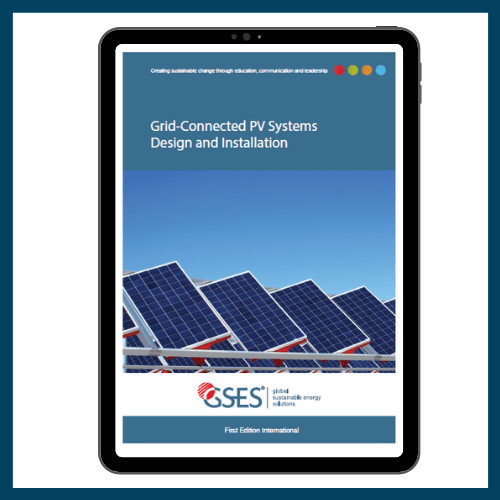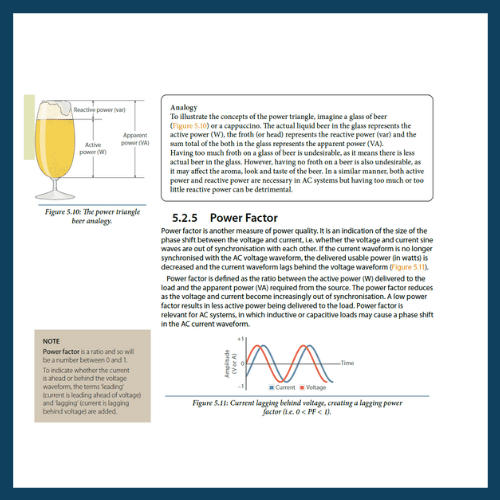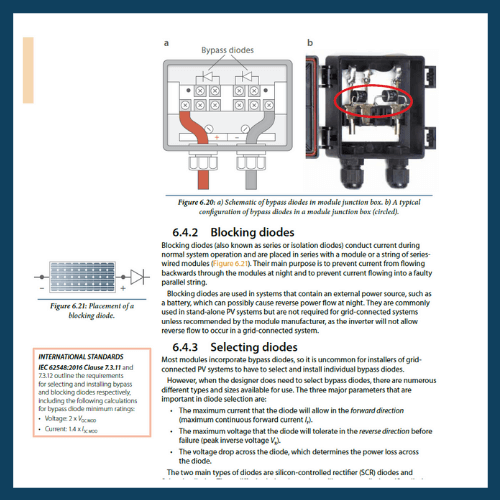Grid-Connected Solar Systems Design Course- International
AUD 155.00
This self-paced online course gives students the skills and knowledge to design a grid connected (grid tied) solar (PV) system in accordance with IEC standards. It also provides knowledge on the installation requirements for a grid connected PV system in accordance with IEC standards and industry best practices.
The course is based on and includes our eBook: International Grid-Connected PV Systems: Design and Installation First Edition. Hard copy books are available upon request.
The course covers the Standard : IEC62548: Installation of PV Arrays. The standard is not included in the course.
Participants who complete the course will receive a digital certificate of completion from GSES.
If the participants are located in the Pacific islands the certificate will state that they have successfully completed the registered Unit Standard:
PPAGC100 Designer of Grid Connected PV Systems
listed in the Pacific Qualifications and Standards Register (PQSR).
Please Allow 1 Business Day for Enrolment details to be emailed to you after purchase.
Note: The Australian version of this course is available for those people located in the Pacific region that follow Australia and New Zealand Standards.
The material in the online course also covers all the theory relating to the installation of grid-connected PV systems, however, to complete the installation section of the course requires attending a 3-4 day practical session. A quotation could be provided for conducting this course in your country.
Prerequisites
All course participants should have the following skills:
- Some knowledge of safe work practices;
- Minimum Senior Secondary School maths (or in-country equivalent) skills for solving standard problems; and
- Minimum Senior Secondary School English (or in-country equivalent) and reading skills.
All course participants must be able to read and understand English.
It is preferred that the participants already have knowledge and skills in:
- Electricity, electrical terms, and common formulae;
- Working knowledge of tools and meters used in installation and maintenance of electrical systems; and
- Basic customer education and service practices.
Though having these skills is preferred, the attendees can learn some of these skills during the online course or with extra work while completing the course.
Delivery Method and Duration
Students work through the course at their own pace. GSES has a team of tutors who mark the online work and as necessary supply feedback or additional technical information to the students. GSES’s tutors are also available to be contacted by phone during business hours or email.
The course is expected to take between 40-80 hours to complete, although this will vary between students. Online course access is valid for 12 months, and will expire afterwards. The E-book does not expire.
A computer with internet connection and a free Adobe Account is required to access the materials. Refer to the E-Book Page for more information.
Assessments and Certificate
Chapter Exercises
At the end of each chapter there are a few optional exercises for students to practice with before attempting a quiz
Chapter Quizzes (Assessments)
At the end of each session there is an online quiz. The student must obtain 100% in each of these quizzes to complete the course.
Online Final Examination
At the end, a final examination recaps material from all chapters. Once Submitted, the exam will be graded by a tutor, and feedback given via email. The student has 3 attempts to pass the final exam with a 90% or better score.
Certificate
After successfully completing the online quizzes, exam and the design task the student will be awarded a certificate from GSES that states:
Name of Person
Had successfully completed the course titled
Design and Installation of Grid Connected PV Systems
And has been deemed competent in: Design of Grid Connected PV Systems
Cancellation and Refunds
Cancellation of online training courses will be subject to the following conditions:
- Cancellation of online training courses made within fourteen (14) days of the date of payment AND before the online course has been accessed: the student will receive a full refund of the online course payment.
- Cancellation more than fourteen (14) days after the date of payment OR after the online course has been accessed (whichever occurs first): the student will receive no refund.
- All course refunds are exclusive of the price of the supplied course publication as advertised at the time of enrolment, unless the publication is returned to GSES in an undamaged and unused condition. GSES reserves the right to refuse a refund of the publication on the basis that goods are damaged or have been used prior to return.
Detailed Course Contents
Introduction to Grid-Connected Solar PV Systems
• Why Solar PV?
• Grid-Connected PV Systems
• Types of Grid-Connected PV Systems
• Work Place Health and Safety International Practice
• Developing a WH&S Procedure
• On-site Risk Assessment
• Common Hazards and Controls
Introduction to Electrical Basics
Characteristics of DC Electricity
• DC Circuits
• Working with DC Electricity
• Introduction to AC Electricity
Solar Radiation
• Measuring Solar Radiation
• Capturing Solar Radiation
PV Cells
• Electrical Characteristics of a Solar Cell
• The Effect of Combining Solar Cells
• The Effect of Combining Solar Modules Connecting to the Grid Overview of the Grid
• Characteristics of AC Electricity
• Interconnection with the Grid
PV Modules
• Types of Solar Cell Technology
• Manufacturing Solar Modules
• Protection of PV Modules
• Module Reliability
• PV Module Warranty
Inverters
• Inverter Specifications
• Types of Inverters
• Grid-connect Inverter Protection Systems
Mounting Systems
• Engineering Certification
• Wind Loading
• Module Orientation and Mounting Configuration
• Roof-mounting Systems
• Mounting Frame: Flush and Tilted Mounting
• Roof Attachment: Roofing Brackets
• Module Attachment: Mounting Clamps
• Building-integrated PV
• Ground-mounting Systems
• Types of Ground-mounting Systems
• Ground-Mounted System Row Height
Balance of System Equipment
- Cabling & Electrical Protection
- Protection Devices: Fuses and Circuit Breakers
- DC Overcurrent
- Protection Devices
- DC Disconnection Devices
- AC Disconnection Devices
- Earthing
- Lightning Protection
- String and Array Combiner Boxes
- Metering
- System Monitoring
Energy Assessment
• Load Shifting & Assessment
• Introduction to Energy Efficiency
• Heating and Cooling
• Energy Efficiency: Hot Water
• Lighting
• Energy Efficiency: Appliances
Site Assessment
• On-site Assessment
• Site Assessment for the PV Array
• Site Assessment for the Array Mounting
• Site Assessment for the Inverter
• Site Assessment of the Grid Connection
• Climate Assessment
• Maintenance and Security
Matching Array and Inverter
• Overview of Matching Array and Inverter Calculations
• Matching the Array and Inverter: Voltage
• Matching the Array and Inverter: Current
• Matching the Array and Inverter: Power
• Oversizing the Array
• Multi-MPPT and Multi-input Inverters
System Protection
• DC Overcurrent Protection
• DC Disconnection Devices
• AC Overcurrent and Disconnection Devices
• System Earthing
• Lightning Protection
• Residual Current Device (RCD)
Cable (Wiring ) Design
• DC Cable Design
• AC Cable Design
System Efficiency and Yield
Sources of Energy Loss
• The Energy Yield of a PV System
• System Performance Assessment
System Installation Standards and Best Practice
• Installation Preparation
• Installation of the PV Array
• Installation of the Inverter
• System Protection and Disconnection
• General Cabling
• Earthing
• Monitoring
• Signage
• System Equipment
System Commissioning System Verification
• System Validation
• Additional Commissioning Steps
Maintenance and Trouble Shooting
System Maintenance
• Troubleshooting
Economics of Grid Connected PV Systems
Initial System Cost
• PV System Rebates
• Ongoing Cost of PV Systems
• Ongoing Benefits of PV Systems
o Electricity Offset
o The Cost of Electricity
o Feed-in Tariffs
• Estimating the Economics of a PV System
• Life Cycle Analysis
• Levelised Cost of Electricity
Commercial and Utility Scale PV Systems
Preliminary Design Process
• Design Considerations for Large-scale Systems
• Large-scale Grid-Connected PV System Design Process
Videos:
• Risk Assessment and Safety
• Harnesses, Equipment, MC4 connectors, Winches and DC cabling
• Tiled Roofs
• Installation of Rooftop Isolator
• System Earthing
• Cabling
• Inverter Mounting
• PV Array DC Isolator Installation
• Video: Commissioning
E- Book Activation
How to Activate
This course includes your Resource E-Book. The checkout page and your order confirmation email will include a download link. Please ensure you enter the correct email for delivery.
This e-Book is only accessed by the free reader Adobe Digital Editions which you can download here for Windows, Macintosh the App Store or Google Play.
You can authorise your computer or make a free Adobe ID account.
Once Adobe Digital Editions is installed, click on your downloaded eBook file and Digital Editions will open your eBook!
If you do not receive this email, or are having problems please contact us on +61 2 9024 5312 or email: info@gses.com.au
Tutor Help
You are not alone in your solar education journey! Your course purchase includes our team of tutors from GSES India who will support you as you progress through the course. You are about to make an investment in yourself, and we want you to finish! Students can email their working and attempts at problems and the tutors will reply promptly during business hours.




